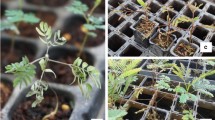Abstract
In late 2003, a new disease appeared in protected bean crops in southeastern Spain, causing a decrease of over 50% in production. Several samples of affected plants were collected and analyzed and the agent of this disease was identified as the bacterium Erwinia aphidicola, which had never been described as a pathogen previously. We attempted to determine the possible bacterium transmission through seeds, using 120 commercial bean seeds from the same batch as that used in an affected farm, and 120 seeds from the fruiting plants of the same farm. Seed coats, cotyledons and leaves of plants originating from them, were taken and analyzed. Several of the developed symptoms on plants from commercial and fruiting plant seeds were internervial chlorosis, necrotic pits and rough roots and they coincided with those observed on affected crops. Bacteria present in commercial seed cotyledons were isolated and analyzed by biochemical and molecular tests. Results confirmed the presence of Erwinia aphidicola in four analyzed seeds; moreover, Bacillus simplex/Bacillus muralis, Pseudomonas mendocina, Pseudomonas putida and Paenibacillus polymyxa were also identified.



Similar content being viewed by others
References
Bustard, K., & Gupta, R. S. (1997). The sequences of heat shock protein 40 (dnaJ) homologs provide evidence for a close evolutionary relationship between the Deinococcus-Thermus group and cyanobacteria. Journal of Molecular Evolution, 45, 193–205.
Diánez, F., Santos, M., Font, I., de Cara, M., & Tello, J. C. (2009). New host for the enterobacterial phytopathogen Erwinia persicina. In A. Mendez-Vilas (Ed.), Current research topics in applied microbiology and microbial biotechnology (pp. 78–82). Singapore: World Scientific Publishing Co. Pte. Ltd.
Gams, W., Plaats-Nitterink, H. A., van der Samson, R. A., & Stalpers, J. A. (1980). In: CBS course of mycology, 2nd edn. Baarn, The Netherlands: CBS.
González, A. J., Tello, J. C., & de Cara, M. (2005). First report of Erwinia persicina from Phaseolus vulgaris in Spain. Plant Disease, 89, 109.
González, A. J., Tello, J. C., & Rodicio, M. R. (2007). Erwinia persicina causing chlorosis and necrotic spots in leaves and tendrils of Pisum sativum in southeastern Spain. Plant Disease, 91, 460.
Hagborg, W. A. F. (1970). A device for injecting solutions and suspensions into thin leaves of plants. Canadian Journal of Botany, 48, 1135–1136.
Harada, H., Oyaizu, H., Kosako, Y., & Ishikawa, H. (1997). Erwinia aphidicola, a new species isolated from pea aphid, Acyrthosiphon pisum. The Journal of General and Applied Microbiology, 43, 349–354.
Klement, Z. (1963). Rapid detection of the pathogenicity of phytopathogenic pseudomonads. Nature, 190, 299–300.
Klement, Z. (1982). Hypersensitivity. pp. 149–177. In M. S. Mount & G. H. Lacy (Eds.), Phytopathogenic prokaryotes. New York, NY: Academic.
Mullis, K. B., & Faloona, F. (1987). Specific synthesis of DNA in vitro via polymerase chain reaction. Methods in Enzymology, 155, 335–350.
Pham, H. N., Ohkusu, K., Mishima, N., Noda, M., Monir Shah, M., Sun, X., et al. (2007). Phylogeny and species identification of the family Enterobacteriaceae based on dnaJ sequences. Diagnostic Microbiology and Infectious Disease, 58(2), 153–161.
Saiki, R. K., Gelfand, D. H., Stoffel, S., Scharf, S. J., Higuchi, R., Horn, G. T., et al. (1988). Primer-directed enzymatic amplification of DNA with a thermostable DNA polymerase. Science, 239, 487–491.
Santos, M., Diánez, F., Miñano, J., Marín, F., Martínez, S., de Cara, M., et al. (2009). First report of Erwinia aphidicola from Phaseolus vulgaris and Pisum sativum in Spain. Plant Pathology, 58, 1171–1171. doi:10.1111/j.1365-3059.2009.02106.x.
Spröer, C., Mendrock, U., Swiderski, J., Lang, G., & Stackebrandt, E. (1999). The phylogenetic position of Serratia, Buttiauxella and some other genera of the family Enterobacteriaceae. International Journal of Systematic Bacteriology, 44, 846–849.
Author information
Authors and Affiliations
Corresponding author
Rights and permissions
About this article
Cite this article
Marín, F., Santos, M., Carretero, F. et al. Erwinia aphidicola isolated from commercial bean seeds (Phaseolus vulgaris) . Phytoparasitica 39, 483–489 (2011). https://doi.org/10.1007/s12600-011-0190-4
Received:
Accepted:
Published:
Issue Date:
DOI: https://doi.org/10.1007/s12600-011-0190-4




